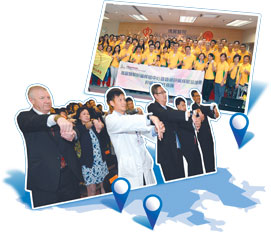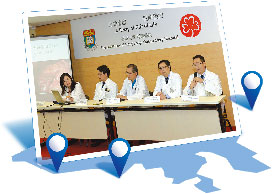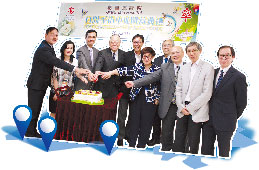Hong Kong West Cluster (HKWC)
Number of general outpatient clinics6
Throughput
Number of beds 3,142
Patient discharges* 197,818
A&E attendances 128,855
Specialist outpatient attendances (clinical) 851,826
General outpatient attendances 389,451
Full-time equivalent staff 7,750
HKWC has continuously fostered close partnership with Li Ka Shing Faculty of Medicine of The University of Hong Kong in supporting undergraduate and postgraduate medical education, training, research and development, as well as innovations in healthcare technology and services. Redevelopment of QMH is one step ahead in enhancing future partnership.
Manpower shortage is one of the main concerns of HKWC. To allay shortage, nursing manpower was reinforced to meet operational needs at acute settings and high pressure areas. Additional allied health professionals were recruited to enhance support for patients requiring multi-disciplinary care and rehabilitation. Additional patient care assistants were hired to share out simple clinical and clerical workload.
 |
Service capacity for high demand life threatening diseases including end-stage kidney disease, cancer, stroke and blood diseases was strengthened through enhancement in technologies, care coordination, transplantation and long-term ventilator care. This included improving pre-phase service for liver transplant patients, enhancing day |
care service for haemopoietic stem cell transplant patients, and supporting the care of ventilator dependent patients in MMRC as well as implementing 24-hour thrombolytic service for acute ischaemic stroke patients in QMH. Surgical capacity for eye procedures was enhanced through additional operating theatre sessions in GH. Besides, through participating in the HA Integrated Chinese-Western Medicine Pilot Programme Phase I, TWH had started to provide Chinese medicine treatment for eligible stroke patients since September 2014. |
Chronic diseases were better managed through enhancement in endoscopy service, computed tomography (CT), lung function laboratory, and rheumatology services. 3,000 CT examinations and 150 lung function laboratory tests were added in QMH per year. The endoscopy service in QMH was reinforced by strengthening nursing support for on-call and emergency endoscopy cases. The nurse-led clinic in QMH was strengthened through effective case triage to provide better care for rheumatology patients.
|
 |
Congestion of medical wards in QMH were alleviated by diverting geriatric patients to FYKH and GH. To provide one-stop cataract service and also to relieve overcrowdedness of eye specialist service in QMH, planning and preparation for relocating the eye specialist outpatient clinic to GH was in progress, targeting to upgrade the cataract operating theatre. The renovated Cataract Centre in GH started serving patients in February 2015, providing three operating theatres. |
 |
Service models with enhanced safety were developed. The surgical instrument tracking system was rolled out to TWH to support improved sterilisation service for operating theatres. Re-use of selected types of single use device according to clinical risk prioritization was phased out and a barcode-based tracking and archiving system in anatomical pathology laboratories was implemented to ensure correct identification of specimens. |
To keep abreast of modern clinical practice, minimally invasive surgery was adopted in hysterectomy for suitable gynaecology patients. Besides, the quality and safety of medication use for paediatric patients was enhanced through rolling out paediatric clinical pharmacy services to DKCH. Case managers were recruited in QMH and DKCH to spearhead integrated care and community support for children with special care needs. |


